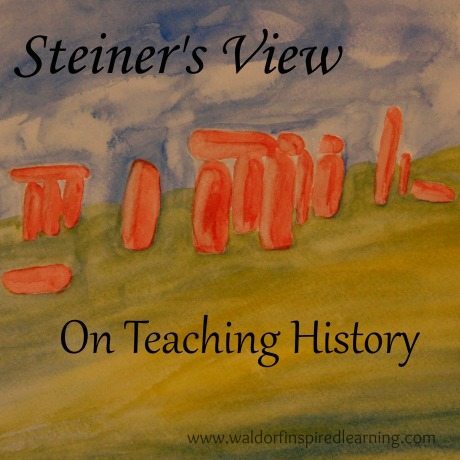Alison and I met at the Steiner Cafe last week after a break for the holidays. And today, we invite you to join us for Day Seven from Discussions with Teachers which begins with a speech exercise. Steiner says, “the object of this exercise is to do gymnastics with the voice in order to regulate the breath.” After the speech exercises, the group reads a fable aloud together.
Let us take this to heart!. Especially for kids over age nine. The point of these opening activities is to warm up our bodies and our breath! Hold that intention. The morning “circle time” of the kindergarten and early grades (grades one and two, maybe three) needs to transform into something simpler as children grow older. Longtime Waldorf high school teacher Steven Sagarin often has his teen students run around the building to warm up and then return to the classroom to recite a morning verse. That’s it. (Check out Sagarin’s blog, What is Education?)
Most of Steiner’s discussion on Day Seven “focuses on the work in the oldest classes” (grades 7+), specifically on teaching history. Here are Steiner’s introductory words: “So we will now speak of certain things that can guide you, and after I have presented this introduction, you will only need an ordinary reference book to amplify the various facts.” Just an ordinary reference book.
Remember that Western Civ class in college? Mine was incessantly boring! How do we teach history otherwise? This lecture tells us!
Steiner demonstrates the teaching of history using the Crusades as an example. His point is that history contains a subjective element. “From reference books you could try to become acquainted with biographies of people … and then bring them to life for your pupils.” The question of which reference materials comes up again later in the discussion. Steiner: “One is often asked these days what history books to read – which historian is best? The reply can only be that, in the end, each one is the best and worst; it really makes no difference which historical author you choose.” No difference.
Love that! Straight from the horse’s mouth, as they say. It doesn’t matter which historical author you choose! Of course, Steiner and his teacher trainees go on to analyze specific historians of their time and Steiner points out the good and bad in each. The bottom line: in teaching history, we want to describe events and specifically people and their lives in a way that brings the time period to life. And particularly the efforts of individuals, their striving that brings change in harrowing circumstances.
Steiner says,
“You see by describing such things and acquiring the necessary pictorial descriptions from reference books, you can awaken in the children themselves pictures of the progress of civilization – pictures that will live on in them. And that is the important thing – that children be given these pictures…If you can then show them works of art, notable paintings from this period, you will find this supports what you say.”
Here is a summary of Steiner’s tips for teaching history:
- Describe the great expeditions.
- Paint a graphic picture of the goals of different groups of people.
- Describe vividly how great tasks undertaken by individuals or groups “arose from the circumstances themselves.”
- Bring the period of history alive again for the children.
- Describe how expeditions came to understand many new things in the new lands they explored.
- Through biography, communicate that in the course of human history, there are so many examples of striving for good out of a place of challenge.
- Illustrate that discord then triumph leads to a rich spiritual and cultural life.
Another sigh of relief here for Waldorf homeschoolers everywhere! Focus on biography during the middle school years when we teach that broad sweep of history from the eleventh to the seventeenth centuries (and all the way to the present). Biography, and triumph over challenge. Using whatever history reference speaks to us. We can do that!
This discussion ends with Steiner addressing the behavior question posed the day before: “how to treat a class where several boys and girls have developed a foolish kind of adoration for the male or female teacher.” Not that this applies so much at home, but Steiner’s suggestions for helping children with their challenges are great!
- Pray
- Say to the child, “you look too warm. Perhaps you should go outside.”
- Each child should be treated individually.
- Steiner says that as teachers “you really have to acquire the art of making (the children) think you are unaware of this unwanted behavior.”
- Tell a humorous story.
- Go for a walk.
Another great lecture to those first Waldorf teachers back in 1919!
What are your thoughts on teaching history? Does this lecture provide you any new insights?
The Steiner Cafe is a place to explore and reflect on the lectures that Rudolf Steiner gave at the Teacher’s Seminar in 1919, the very first Waldorf teacher training. Each month here, we ponder one day of the seminar.
To read reflections on previous lectures, check out The Steiner Cafe page.
These lectures are published in three books; the morning lectures in The Foundations of Human Experience; later morning lectures in Practical Advice to Teachers; and afternoon lectures in Discussions with Teachers. We invite you to pick up the books and read along.
If you prefer, you can read online at www.rsarchive.org, or listen at www.rudolfsteineraudio.com. Or, just meet us here each Thursday or Friday at The Steiner Cafe for some lively discussion. Lot’s of options! Hope you’ll join us.




You two are my mentors for teaching in general and teaching history in specific. I use “A Little History of the World” as my reference book, as per your recommendation, Jean. And we are starting the Renaissance this week by augmenting that book with several biographies by Diane Stanely, thanks to Alison’s recommendation.
My seventh grader has been slowly working his way through “A Little History” (with me reading it to him) since the end of 5th grade when we did Greece. We also pair this with a continuing timeline project – again thanks to advice from you and Alison.
xoxo to both of you.
I honestly don’t know where I would be without you.
S
Thank you my dear. You are an inspiration to me, too! It’s so much fun to share resources. And to know that our job is to look over a few, find one that speaks to us for that block, and get on with it! No more getting hung up on the perfect resource, right!?!
Sorry for the late comment, just catching up on a bit of blog reading. Thank you for this series of posts, I really appreciate the work you and Alison put into producing them.
And thank you, Sheila, for your comment. I had been using “Story of the World” as a reference but found that I would get an idea for an activity or want a bit more info/clarification on something so I’d go on-line to search and discover…agh!!….the information in Story of the World was wrong/different to Wikipedia or some other site. Then I’d spend a ridiculous amount of time trying to figure out which was correct because, as the “teacher”, I don’t want to give the wrong info! This has happened so many times now I’ve lost faith in “Story of the World”.
So I’m going to try “A Little History of the World” instead.
I am getting better at the whole less resources/stop looking thing. One day at a time 🙂 Thank you!
Cathy
Very helpful, Cathy, your description of using Story of the World. I see the appeal of it but I’ve never felt there was enough depth or threads from one topic to another. And we all struggle with stopping the frantic search for the next better resource! You are not alone. One day at a time, fore sure!
I laughed out loud at the “you look too warm. Perhaps you should go outside.” I was just saying to my daughter yesterday that in early childhood the Waldorf answer is to warm them up! 😀
Ha, yes, Kellie! ?